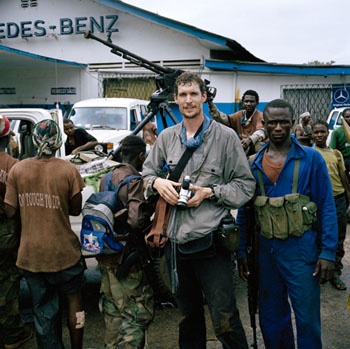Conjure a combat photographer in your mind’s eye — fatigues, a whiskey flask and a fondness for rude pastimes. Now discard the cliché and conjure Chris Hondros of Getty Images instead. A tweed blazer with elbow patches. A taste for martinis. A love of Mahler. And a passion for chess.
Mr. Hondros, 41, was mortally wounded Wednesday in Misurata, Libya, not long after filing intensely close-up pictures of the fighting between rebel and government forces. Tim Hetherington, the director and producer (with Sebastian Junger) of the documentary “Restrepo,” was killed in the same attack. Two other photographers — Guy Martin and Michael Christopher Brown — were injured.
Colleagues spoke on Wednesday of Mr. Hondros’s quiet drive, his steady friendship and his devotion to his fiancée, Christina Piaia. They also recalled several distinguishing habits and passions. “He would be conducting with his hands as walked around,” said Chip East, a photojournalist. “He knew more about classical music than anyone I know. He knew every beat to every symphony, every opera.”
“We used to play chess when we had no money,” Mr. East said, remembering how he and Mr. Hondros had quit the same newspaper in Fayetteville, N.C., and wound up living together in Jersey City for about five years. “We used to go the old chess club just south of Washington Square Park. It was cheap to play there. He was a hell of a chess player.”
And his attire? “For the first three or four years I knew him, he used to show up in war zones with this blazer,” Samantha Appleton recalled. “He just felt safe in it. We all would tease him. In Bethlehem, during the Second Intifada, it was really hot. And he had this blazer on.”
Ron Haviv (who remembered the blazer as corduroy) said Mr. Hondros’s approach to coverage mirrored that deliberate, cultivated bearing. “Chris is unique in his very cool deportment,” Mr. Haviv said on Wednesday. “He’s very measured. He works by always being well informed. He’s a pure photographer and a pure journalist. He works with a purpose.”
 Chris Hondros/Getty Images A Mubarak supporter rode into the crowd in Tahrir Square on Feb. 12. Ron Haviv said Mr. Hondros was one of the few to capture this moment in the Egyptian uprising.
Chris Hondros/Getty Images A Mubarak supporter rode into the crowd in Tahrir Square on Feb. 12. Ron Haviv said Mr. Hondros was one of the few to capture this moment in the Egyptian uprising.That purpose propelled Mr. Hondros through a career of perilous postings, said Tyler Hicks, a staff photographer for The New York Times who was held captive in Libya last month with three colleagues.
“He’s a sensitive photographer,” Mr. Hicks said. “He never was in it for himself or for the vanity of what the job brings with it. He really believes in his work.”
It was a drive, Mr. Hicks said, that comes from the inside, and he added, “And Chris has it.”
“He wanted to tell the story,” Mr. Hicks said. “He wanted to show the world what was going on. And he was willing to take the personal risk and make the personal sacrifices to go along with that.”
Mr. Hondros spoke with Lens in February about those risks after he was assaulted twice covering the uprising in Egypt. Mr. Haviv remembered something else about that time in Tahrir Square, when Mr. Hondros made a point of sticking by the photographer Scout Tufankjian.
“She kept getting manhandled as she made her way through the square and Chris made it a real purpose to protect her,” Mr. Haviv said. “He was standing behind her and chatting up the men and embarrassing them to the point that they would leave her alone — while concentrating on what he was doing.”
There are those awful moments, however, when no amount of prudence or vigilance can help.
“There’s no illusion that something won’t happen to you when you are working in a place where people are getting hurt or killed,” Mr. Hicks said. “When you’re recording the hardship of people’s lives, that is something you also take upon yourself. And that kind of dedication — to put yourself out there to tell that story, and to show people what’s happening in these places, what people are going through in conflicts around the world — that takes a special person.”
As Bryan Denton tried to take in the news on Wednesday, he spoke of a happy hope he had been entertaining since he’d learned that Mr. Hondros and Ms. Piaia were thinking about moving to the Middle East. “We debated whether to consider Cairo or Istanbul, and discussed the merits of Beirut, where I live,” Mr. Denton said in an e-mail. “I remember thinking to myself that it would be cool to have them in town, especially since it would mean that his legendary parties would now be held around the corner.”
 André Liohn Chris Hondros of Getty Images, photographed while at work in Misurata, Libya, on Wednesday, before he was mortally wounded.
André Liohn Chris Hondros of Getty Images, photographed while at work in Misurata, Libya, on Wednesday, before he was mortally wounded.













 Charles Moore, who braved physical peril to capture searing images like lawmen using dogs and fire hoses against defenseless demonstrators, died Thursday in Palm Beach Gardens, Fla., Douglas Martin writes in The Times.
Charles Moore, who braved physical peril to capture searing images like lawmen using dogs and fire hoses against defenseless demonstrators, died Thursday in Palm Beach Gardens, Fla., Douglas Martin writes in The Times.


